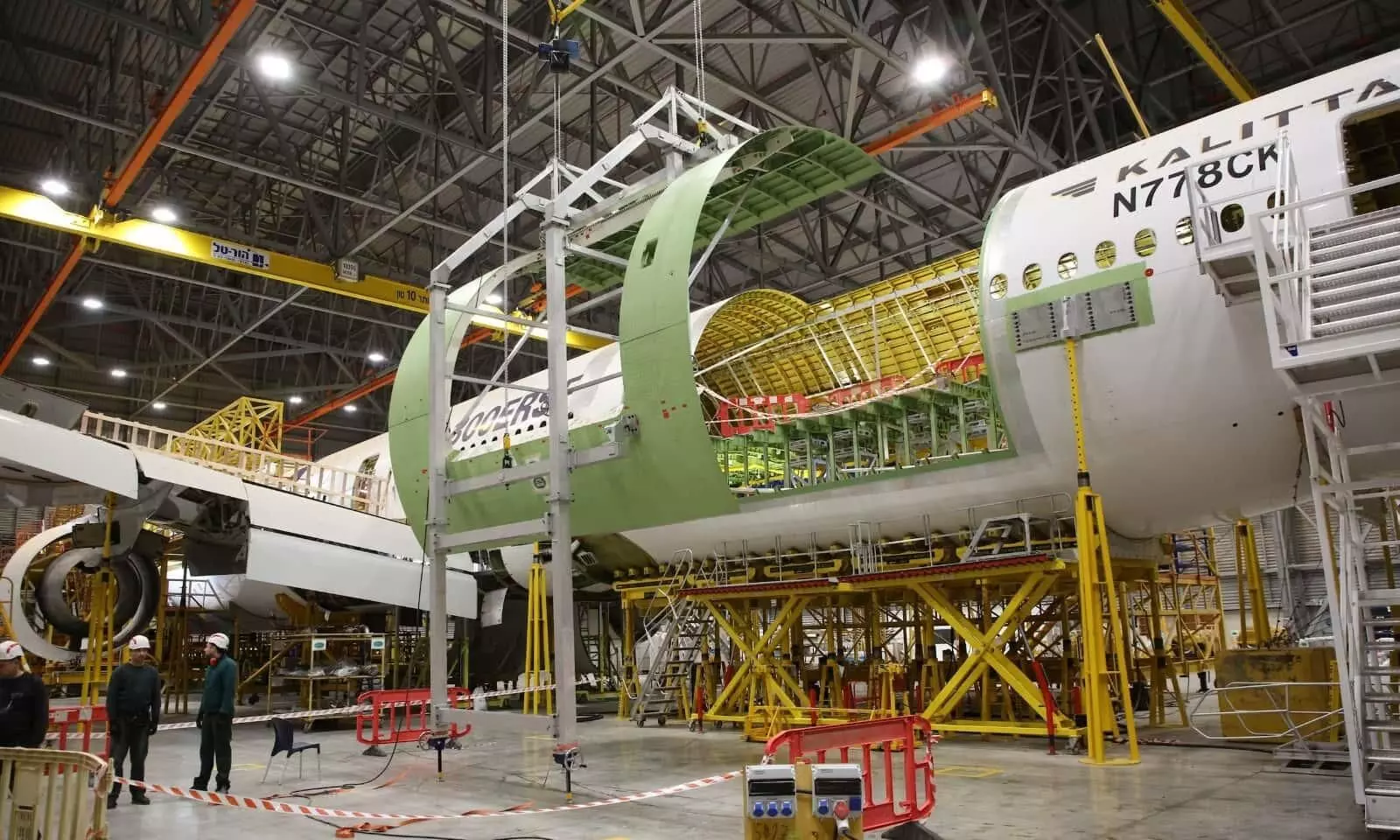
P2F demand steady now but outlook uncertain
Bearish trends in cargo demand, along with rising passenger growth, is not helping passenger-to-freighter conversions

With the air freight market slowly picking up and rates/tonnages inching into the positive zone after a long lull, the focus could shift to conversions - passenger to freighters (P2Fs) but with multiple challenges.
IBA, the leading aviation market intelligence and consultancy company, has indicated signals of potential oversupply of the Boeing 737-800 passenger to freighter (P2F) aircraft with 60 conversions forecast for this year alone.
IBA also highlights that 737-800 has been converted at a faster rate than any other P2F programme. "The total 737-800 P2F fleet is on course to surpass the 757-200 P2F fleet of 311 aircraft, which IBA believes suggests a risk of oversupply based on the rapid fleet growth. Indeed, the 737-800 continues to lead the narrowbody conversion market with conversions of the A321-200 remaining steady as expected with 20 planned for this year."
Boeing, the leader in P2F conversions, estimates a demand for approximately 2,800 production-plus-conversion deliveries over the next 20 years. "This will include around 1,300 standard-body freighter conversions such as the 737-800BCF, and more than 600 wide body conversions such as the 767-300BCF," according to a spokesperson for Boeing.
Supply chain challenges
Conversion experts like IAI and EFW are facing multiple challenges - supply chain bottlenecks, shortages of expert technicians and delayed regulatory approval of modification designs. "While the industry, at large, is dealing with staff shortages and an increase in raw materials prices, this certainly appears to have affected the OEMs, in particular Boeing," says Jon Whaley, senior aviation analyst, IBA. "While raw material price increases mean P2F converters might have to pass some of this on to customers, IBA do not see the P2F community being affected so drastically. One only needs to look at the record numbers of Boeing 737-800s being converted both in 2022 and 2023 to prove the point."
Market values and lease rates for converted 737-800s are no longer commanding the premiums they were as the fleet grows in number while at the same time the cargo market as a whole cools off: Jon Whaley, senior aviation analyst, IBA
EFW recently did the first door cut for the very first A321P2F conversion at Haite in Tianjin. The aircraft has gone through heavy structural works, and will soon be ready to get installed with its new big main deck cargo door.
The supply chain challenges for conversions are similar to the challenges facing production and aftermarket – there is a general lack of feedstock and work labour for the entire industry, resulting in competition for the same material and staff versus the passenger division, according to Andreas Nyman, Vice President, Global Head of Aerospace, Kuehne+Nagel. "We are also seeing delays in production by engine and airframe OEMs, creating long delays which furthermore impact the scheduled conversion."
Bear market and conversionsThere will generally always be a need for some conversion activity annually - to what level however is the question, says Whaley of IBA. "The 737-800BCF conversion rates in particular remain strong, though there is no ignoring how risky the credits are becoming. We know that EFW will remain by their steady approach to conversion activity for all four of their programmes (A320-200P2F, A321-200P2F, A330-200P2F, A330-300P2F), preventing the market from any oversupply. The cargo market at the moment is rather turbulent compared to the pandemic years, yet conversion activity remains rather high. The likelihood is in the case of 737-800BCF conversions that we do see a slowdown due to the market only being able to accommodate so many examples. Boeing 777-300ER conversions are likely to occur but expect numbers to be relatively limited due to the costs associated with the conversion and only a limited number of operators/lessors in such a situation that allows them to commit to the programme."
A view echoed by Nyman of K+N when he says: "Yes, we do believe that there will continue to be a demand for conversions. Worth mentioning is that the current freight market is acting anti-cyclical: passenger demand is so intense that it impacts the cargo focus. As aviation is a long-term business, most asset owners still predict a return on their investments, an investment that might have a longer return time than predicted during the pandemic. The drop in cargo demand is outweighed by the increase in passenger demand. Sharing a similar feedstock, creates a more likely, faster, return on the passenger side than the cargo market."
Regulatory changes
A passenger-to-freighter conversion calls for strict regulatory interventions to ensure stability of the aircraft. It can take four to eight months to reconfigure an aircraft for cargo, depending on size and the number of available repair bays for particular aircraft types. "There has been little to no impact from a logistics perspective. This is more related to regulatory changes in collaboration with the authorities and the airframe OEMs. Approvals around supplemental type certificates (STCs) to install the necessary modification for a converted aircraft have caused delays," says Nyman of K+N.
Environmental considerations such as the disposal of the removed fuselage passenger frame must be considered, adds Whaley of IBA. "In effect, parts like this will have to be recycled and therefore will be subject to the same environmental responsibility as a tear-down aircraft. In terms of the emissions regulations that are due in 2028, this only affects new production aircraft, in effect making all P2F programmes such as Boeing 737-800, Boeing 767-300ER, Airbus A321 and A330 exempt."
Narrow bodies continue to be in demand
"Our current and future lineup of Boeing Converted Freighters play a central role in e-commerce and express cargo markets, delivering the capability, reliability and efficiency our customers need today, and going forward," says the Boeing spokesperson. "The 737-800BCF is a proven global solution with more than 250 orders and commitments to date, and more than 130 deliveries since 2018. The airplane has the largest and broadest operator base with more than 40 operators and counting, across more than 20 countries and five continents. The 767-300BCF is the market-preferred solution for general and express cargo markets and has more than 100 orders and commitments to date, and more than 80 deliveries.”
Whaley of IBA adds: "There are operators of Boeing 737-300, 737-400 and older 757-200 freighters which will require replacement either now or in the near future. The ASL Group, which is the largest 737-800BCF/SF operator with significant 737-300/400 freighter operations, is in a fleet replacement process with a number of the classics having already been removed from service. ASL has previously mentioned that some of their 737-400s would remain in service, should demand warrant it. ASL is just an example of a host of operators doing the same thing. Then there is, of course, the many start-ups which have been established in the wake of the pandemic peak for air freight and e-commerce, these being the riskier credits which were referred to earlier."
We do believe that there will continue to be a demand for conversions. Worth mentioning is that the current freight market is acting anti-cyclical: passenger demand is so intense that it impacts the cargo focus: Andreas Nyman, Vice President, Global Head of Aerospace, Kuehne+Nagel
A view backed by Nyman of Kuehne+Nagel when he says: "We are currently seeing more narrow-body conversions with a focus on the B737 and A321 as the main flight types being converted. It is based on several factors – two main reasons being that they have the largest feedstock availability and there are also more assembly lines with the conversation capabilities to handle those flight types. Some of the benefits of narrow-body conversions are that they are faster and have a larger feedstock than wide-body."
P2F outlook
There are still three-four years of pent-up demand based on current waiting time, which reached a peak late last year, Nyman added. "However, the demand (additional ordered/booked conversions) is declining with the current market trend."
Whaley of IBA, too, says that demand for most types are declining "from where we were during the Covid pandemic when demand for freighter-configured aircraft escalated to previously unseen levels. Market values and lease rates for converted 737-800s are no longer commanding the premiums they were as the fleet grows in number while at the same time the cargo market as a whole cools off. Other types have not seen such a cooling off, largely due to the more controlled and steadier rate at which other aircraft types are being converted.
"For those older aircraft types, demand will simmer down primarily due to the feedstock becoming rather limited. The 737-300SF, 737-400SF and 757-200 PCF conversion programmes have been active for a very long time and many aircraft have been converted in that time, with most, if not all, of the most desirable assets having now been converted. In the case of the 737-300SF, we are likely only going to see single-figure conversions remaining. Same would be the case for 737-400SFs while the feedstock situation is a bit more upbeat for the 757-200PCF, and we should see a moderate number of conversions still to come over the years but definitely not to the levels we have seen previously.
"The 767-300ERBCF/BDSFs are also now entering that twilight stage with more and more A330-300P2Fs completing the conversion process. That is not to say we are not seeing conversions of Boeing 767-300ERs as aircraft continue to go to facilities around the world but over the coming years, the number of annual conversions is likely to decline as suitable feedstock becomes more and more difficult to secure."

